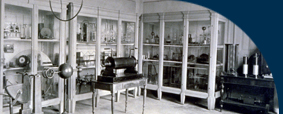
 |
Volta's pistol [1] |
 |
Pistola di Volta |
| Subjects: electrochemistry/eletrical spark gaseous detonator |
Settore: elettrochimica/detonatore gassoso da scarica elettrica |
| Inventory Number: 5 |
Numero di inventario: 5 |
| Unsigned |
Non firmata |
| Before to 1842 [historical inventory] |
Periodo di costruzione: Precedente al 1842 [inventario storico] |
| Oak, brass, glass, cork, lacquered wax |
Materiali utilizzati: Rovere, ottone, vetro, sughero, ceralacca |
| Barrel: Ø max. 55 mm; length: 265 mm |
Dimensioni: Canna: Ø max. 55 mm; lunghezza: 265 mm |
| |
|
This device shows the chemical explosive effects of the electric spark up on certain gaseous mixtures. Its creation derives from the studies relating to the progress of pneumatic chemistry in the 18th century. From Boyle to Lavoisier, the studies recorded the discovery and classification of new gases, providing, in particular, information about the nature and the chemical properties of air. Among the contributions to such progress there was also the activity of the famous physicist Alessandro Volta of Como (1745-1827), which culminated in the discovery of natural gas or of the "inflammable air typical of the marshland", as it was originally called, in the autumn of 1776. The discovery induced Volta to study the nature and the properties of the new gas and to carry out many experiments on the "new air's capacity" to ignite. From the results of this experiment, he also invented the electric pistol, whose most important novelty was the possibility of making the "booming mixture" explode in a closed environment by means of an electric spark that Volta generally obtained with a small "pocket-size electrophorus".
|
Questo dispositivo mostra gli effetti chimici esplosivi della scintilla elettrica su opportune miscele gassose. La sua ideazione è riconducibile agli studi e ai progressi della chimica pneumatica del XVIII secolo. Da Boyle a Lavoisier, tali studi avevano registrato la scoperta e la classificazione di nuovi gas, fornendo in particolare informazioni sulla natura e le proprietà chimiche dell'aria. Tra gli artefici di tali progressi c'è anche l'opera del celebre fisico comasco Alessandro Volta (1745-1827) suggellata dalla scoperta, nell'autunno del 1776, del metano o dell'"Aria infiammabile nativa delle paludi", secondo la sua definizione originaria. Tale scoperta portò il Volta a studiare la natura e le proprietà del nuovo gas, a produrre numerose esperienze sulla capacità infiammatoria della "nuova aria" ed a trarre da esse l'invenzione della pistola elettrica, la cui novità più rilevante era quella di far scoppiare la "miscela tonante" in ambiente chiuso attraverso una scintilla elettrica che il Volta ricavava, generalmente, tramite un piccolo "elettroforo da tasca". |
| |
|
Description: the main part of the pistol is made of brass; the handle consists of two carved oak pieces, which are attached to each other on a brass frame. The firing barrel is closed at one end by a cork. The upper part of the cylinder is pierced and connected with a small vertical brass cylinder, which is completely enclosed within the large cylinder, nearly touching the bottom part of it. The small cylinder is internally insulated by a glass coating and, in the external hole, by sealing-wax. The small cylinder lacks the brass spark gap, a rod with two small spheres at each end, half of which is outside and the other half inside the cylinder and the sphere of which is near the internal wall of the container. Sealing-wax insulates the external part of the electrode of the metallic shell of the pistol. |
Descrizione: il corpo principale della pistola è interamente d'ottone; il manico è costituito da due pezzi lavorati di quercia, saldati a pressione tra di loro su di una base d'ottone. La canna da fuoco è chiusa ad una sua estremità da un tappo di sughero. La parte superiore del tamburo è forata e connessa con un cilindretto d'ottone verticale posto internamente al tamburo, fino quasi a toccare il fondo di quest'ultimo. Il cilindretto è internamente isolato da un rivestimento in vetro e, sul foro esterno, da ceralacca. Il cilindretto è mancante dello spinterometro d'ottone, un'asta con due sferette alle estremità, che emerge per metà all'esterno e per l'altra metà penetra all'interno del cilindro, posizionandosi con la sferetta in vicinanza della parete interna del recipiente. Della ceralacca provvede ad isolare esternamente l'elettrodo dalla cassa metallica della pistola. |
| |
|
Function: The explosive gas charge [1] is prepared to be introduced into the barrel or into the combustion chamber of the pistol. Through an electrostatic machine, a Leyden jar or an electrophorus, an electric spark is sent to the spark gap. This generates a spark in the internal part which causes the "booming mixture" to explode by combustion, thus producing the violent ejection of the cork.
|
Funzionamento: si prepara la carica gassosa esplosiva [1] da introdurre nella canna o nella camera di scoppio della pistola. Tramite una macchina elettrostatica o una bottiglia di Leida o un elettroforo, si comunica allo spinterometro esterno una scarica elettrica; questa genera al suo interno la scintilla che fa esplodere per combustione la miscela tonante, producendo la violenta espulsione del tappo. |
| |
|
Bibliography: Volta [1816], vol. III, pp. 133-174; Ganot [1855], pp. 595-596; Gliozzi [1967], pp. 237-276; Greenslade [1987], pp. 55-57. |
Bibliografia: Volta [1816], Tomo III, pp. 133-174; Ganot [1855], pp. 595-596; Gliozzi [1967], pp. 237-276; Greenslade [1987], pp. 55-57. |
| |
|
[1] Through his numerous experiments, Volta often mixed several gases in different parts. In his opinion, "thundering air" was an explosive mixture of metallic flammable air [hydrogen] and dephlogisticated air [oxygen]. He often mixed the flammable air of the marshes [methane] with ordinary air, or ordinary air with flammable metallic air. |
[1] Volta nelle sue innumerevoli esperienze usava miscelare in diverse proporzioni alcuni gas. "L'aria tonante" era, secondo la sua definizione, una miscela esplosiva di aria infiammabile metallica [idrogeno] ed aria deflogisticata [ossigeno]; talvolta mischiava dell'aria infiammabile delle paludi [metano] con aria comune, oppure quest'ultima con aria infiammabile metallica. |
|
|
|

